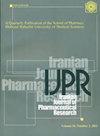设计并鉴定渗透泵系统,优化大肠杆菌培养过程中的进料和 pH 值控制,提高生物量
IF 1.8
4区 医学
Q3 PHARMACOLOGY & PHARMACY
引用次数: 0
摘要
背景:实验室中用于表达筛选和重组蛋白生产等各种目的的批量培养物通常存在一些缺点,这是因为添加葡萄糖和缓冲液等碳源会导致新陈代谢溢出、pH 值降低、渗透压过高、生物量产量低和蛋白质产量低。研究目的本研究旨在通过可控孔隙度渗透泵(CPOP)系统,利用控释概念克服批量培养的问题。方法:CPOP 以葡萄糖为碳源,以碳酸钠为 pH 值调节剂,并在片剂的核心涂上含有醋酸纤维素和聚乙二醇 (PEG) 400 的半透膜。片芯中使用 Eudragit L100 作为缓释剂,包衣膜中使用 PEG 400 作为成孔剂,从而调节释放速率。傅立叶变换红外光谱(FT-IR)和扫描电子显微镜(SEM)分别用于阐明各组分之间的相容性和释放机理。葡萄糖和 Na2CO3 的体外释放研究在矿物培养基(M9)中进行了 24 小时。然后,以大肠杆菌(E. coli)(BL21)(生物质)为微生物模型,评估了 CPOP 在其生长过程中的有效性。在细菌生长过程中,还监测了葡萄糖的消耗、培养基 pH 值的变化以及副产品醋酸盐的浓度。结果傅立叶变换红外光谱证实了渗透泵中各成分之间的相容性,而扫描电镜则阐明了溶解成分(PEG 400)在涂膜上与溶解介质接触时产生的原位输送孔导致的释放机制。体外释放研究表明,渗透泵能以零阶方式释放葡萄糖和碳酸钠。在大肠杆菌(BL21)培养中使用 CPOP 后,与栓剂喂养相比,生物量有了显著提高(超过 80%),在指数期保持了培养基的 pH 值(高于 6.8),并减少了代谢副产物(醋酸盐)的形成(P < 0.05)。结论CPOP 能够控释作为碳源的葡萄糖和作为 pH 值调节剂的碳酸钠,使用 CPOP 可以克服栓饲法的缺点,如 pH 值降低、醋酸盐浓度增加和生产率低等。它具有良好的商业化潜力。本文章由计算机程序翻译,如有差异,请以英文原文为准。
Design and Characterization of an Osmotic Pump System for Optimal Feeding and pH Control in E. coli Culture to Increase Biomass
Background: Batch cultures used for various purposes, such as expression screening and recombinant protein production in laboratories, usually have some drawbacks due to the bolus addition of carbon sources, such as glucose and buffers, that lead to overflow metabolism, decreased pH, high osmolality, low biomass yield, and low protein production. Objectives: This study aimed to overcome the problems of batch culture using the controlled release concept by a controlled porosity osmotic pump (CPOP) system. Methods: The CPOP was formulated with glucose as a carbon source feeding and sodium carbonate as a pH modifier in the core of the tablet that was coated with a semipermeable membrane containing cellulose acetate and polyethylene glycol (PEG) 400. The release rate was regulated with Eudragit L100 as a retardant agent in the core and PEG 400 as a pore-former agent in the coating membrane. Fourier-transform infrared spectroscopy (FT-IR) and scanning electron microscopy (SEM) were used to elucidate compatibility between components and release mechanism, respectively. The in-vitro release of glucose and Na2CO3 studies were performed for 24 hours in a mineral culture medium (M9). Then, the effectiveness of CPOP in the growth of Escherichia coli (E. coli) (BL21) (biomass) as a microorganism model was evaluated. Glucose consumption, changes in medium pH, and acetate concentration as a by-product were also monitored during the bacterial growth. Results: Fourier-transform infrared spectroscopy confirmed the compatibility between the components in the osmotic pump, and SEM elucidated the release mechanism due to in-situ delivery pores created by dissolving soluble components (PEG 400) on the coated membrane upon contact with the dissolution medium. The in-vitro release studies indicated that the osmotic pump was able to deliver glucose and sodium carbonate in a zero-order manner. The use of CPOP in E. coli (BL21) cultivation resulted in a statistically significant improvement in biomass (over 80%), maintaining the pH of the medium (above 6.8) during the exponential phase, and reducing metabolic by-product formation (acetate), compared to bolus feeding (P < 0.05). Conclusions: The use of CPOP, which is capable of controlled release of glucose as a carbon source and sodium carbonate as a pH modifier, can overcome the drawbacks of bolus feeding, such as decreased pH, increased acetate concentration, and low productivity. It has a good potential for commercialization.
求助全文
通过发布文献求助,成功后即可免费获取论文全文。
去求助
来源期刊
CiteScore
3.40
自引率
6.20%
发文量
52
审稿时长
2 months
期刊介绍:
The Iranian Journal of Pharmaceutical Research (IJPR) is a peer-reviewed multi-disciplinary pharmaceutical publication, scheduled to appear quarterly and serve as a means for scientific information exchange in the international pharmaceutical forum. Specific scientific topics of interest to the journal include, but are not limited to: pharmaceutics, industrial pharmacy, pharmacognosy, toxicology, medicinal chemistry, novel analytical methods for drug characterization, computational and modeling approaches to drug design, bio-medical experience, clinical investigation, rational drug prescribing, pharmacoeconomics, biotechnology, nanotechnology, biopharmaceutics and physical pharmacy.

 求助内容:
求助内容: 应助结果提醒方式:
应助结果提醒方式:


